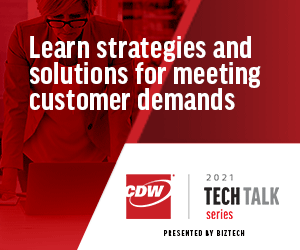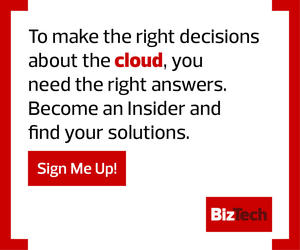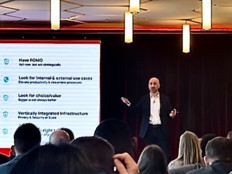Many organizations began decentralizing their IT decision-making years ago, but the trend accelerated with the onset of the pandemic. Individual business units needed to act quickly to enable remote and hybrid work, and many of them adopted solutions and processes specific to their needs.
The Wall Street Journal recently suggested an extreme response to this trend, observing that perhaps “it’s time to get rid of the IT department.” While the WSJ article presents some interesting ideas, those may not be the best answers for every organization seeking to simplify its IT environment.
Jeremy Ross, systems engineering director at Nutanix, joined CDW’s Tech Talk webcast to offer his thoughts on why complexity has crept into the IT environments of so many organizations and how a simplified infrastructure can address it.
Too Many Cooks in the IT Kitchen?
“Within each business unit inside of an organization, they're all working through their own form of a digital transformation of sorts, right? It's hitting every facet of business,” Ross explained. “This creates a desire to move faster and, you know, get to those outcomes as quickly as possible, but there's this overarching requirement to move as one so that all of this comes together in the end the way we hope that it does.”
Ross called complexity the enemy, saying it works against key business objectives. As business units add new IT solutions, “if it's not thoughtfully considered, it creates additional complexity,” he said.
“It puts you at an extreme disadvantage in the sense that if you're not thinking through complexity, or where it exists in your IT operations anyway, then what ends up happening is you fall behind,” he explained. “And the effective use of technology is quickly becoming more of an enabler to business than it ever has been before. And so, if you don't strategically think through how to eliminate what I often refer to as technical debt inside your business, then you slowly start to fall behind.”
Register below for an upcoming CDW Tech Talk, held Tuesdays at 1 p.m., to hear from IT experts live.
Infrastructure Is Key to Simplicity
Ross said a simplified IT environment begins with a business’s underlying architecture. “We don't have to look too far to what a successful design or architecture looks like to support scale and agility.”
And the benefits of a simplified IT environment can be significant, he said. “There’s this idea that we can move faster and reduce cost. And I think that's where the conversation typically starts.”
He also mentioned the benefit of retaining talent, thanks to less complex IT environments. “As things get more complex, some of the top talent you might have in your organization, they become disenfranchised and want to go to an organization that is trying to solve these big problems and make life simpler.”
Adding Automation Can Yield Benefits
Ross pointed out the advantages available when businesses include automated processes in their operations. “We want to be able to automate a lot of what we're doing because the requirement is almost superhuman,” he said. “The only way we're going to be able to meet the demand is if we leverage software to do what's unfit for humans, just in terms of the scale and the level of detail that some of these tasks need.”
Ross said the ability to automate operational tasks associated with each of those responsibilities is really critical at this point, “because when you're not thinking through your design and your architecture from that perspective, then what can happen is, those tasks are either unmet or they're being addressed, but maybe not as completely as they need to be.”
He offered the retail sector as an example of how automation can be used to streamline operations. At certain times of the year, retailers are “going to see a big influx in demand on their online platform or even what's going on in their brick and mortar,” he explained. “And that creates a demand or a need for burstable capacity during that time of year — but it's not necessarily needed throughout the entire year. We’re able to work with customers in such a way that we can, through a high degree of automation, give them the ability to leverage that burstable capacity, whether it be in the public cloud, which is typically what we're seeing now, and then bring that back down as the demand decreases.”
Hybrid Environments Offer Additional Flexibility
CDW’s Lee Washington, vice president of enterprise infrastructure joined the discussion to share some of their experiences in making CDW’s infrastructure more effective by building out a hybrid cloud environment.
Washington explained that the company is going through a very exciting transformation itself and is beginning to leverage “the best of both worlds across cloud and our traditional data center environments. We continue to see growth of platforms within our on-premises data centers, while simultaneously we're seeing a quick uplift and usage of our new cloud platforms.”
Washington detailed the ways in which a hybrid cloud environment has allowed CDW to optimize its operations. “We’re starting to demonstrate the value of a true hybrid scenario in practice, and we are gaining great flexibility in terms of how we want to host and manage various workflows. We can truly now fine-tune placements of various services to meet the needs of the business very, very quickly.”
For organizations looking to implement a hybrid cloud approach, Washington offered suggestions. “The first thing I'd say is, begin with the end in mind. And for us, that is how do we maximize our infrastructure assets to support the business objectives and goals? And that's regardless of whether it's in the cloud or if it's in your traditional on-premises data centers. The goal should be the same.”
He also noted the importance of security when developing a hybrid cloud environment. “Security must be built in,” he said. “You can't innovate at the risk of being compromised or with security holes in place where your data resides.”
Follow BizTech’s full coverage of the CDW Tech Talk series here. Insiders can register for the event series here.












